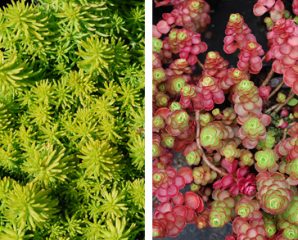Nowadays many residential, as well as commercial customers, regularly use some type of mulch as a ground cover for their planting beds. It may be in the form of pine bark chips, shredded bark, natural hard or softwood chips from trees recently cut down and chipped, or even the different types of stone mulches that are available from mason supply sources. All colors and textures are available.
These mulches are typically replaced or top-dressed regularly in the spring and fall. The cost of yearly maintenance applications continues to increase like everything else. If previous seasons mulch is not removed the increased depth of repeated applications can actually harm plants. The labor to remove the old mulch and dispose of it adds to the yearly cost as well. With increased depth the soil moisture/oxygen mix changes to an anaerobic condition killing plant roots. Stressed plants are more prone to disease and insect infestations which can ultimately lead to a plant’s demise. Mulching, when used in planting beds really is a temporary solution to conserve moisture and control weeds until the plants become established. If designed and planted correctly planting beds should reflect a combination of trees, shrubs, and ground covers (perennial, annual, and/or woody plants) in order to mimic a natural massing and layered effect that is almost self- maintaining and still have an aesthetic appearance.
A more ecological and economical alternative to mulching is to plant ground covers. With so many options for sun, shade, wet and dry areas there are at least as many alternatives as there are mulch options if not more. Ground covers will create the same positive affects that mulches do. They keep the weeds down and conserve moisture. Once an appropriate live ground cover is established the maintenance is relatively minimal. This might include watering until established for the first year or two, some minor weeding, and not much else. The relative cost is obviously larger for the initial installation, but over the long run you can save your customers thousands of dollars. Of the many hardy ground covers that we grow and make available here at Planters’ Choice here are just a few:
- Ajuga reptans ‘Burgundy Glow’
- Juniperus spp. (Low-growing Junipers)
- Arctostaphylos uva-ursi (Bearberry)
- Liriope muscari (Lilyturf)
- Carex pensylvanica (Pennsylvania Sedge)
- Lysimachia nummularia ‘Aurea’ (Golden Creeping Jenny)
- Convallaria majalis (Lily of the Valley) & ‘Rosea’ (Pink Flowering)
- Microbiota decussata (Siberian Carpet)
- Cornus canadensis (Bunch Berry)
- Phlox stolonifera (Creeping Phlox)
- Cotoneaster spp.
- Phlox subulata (Mountain Pinks)
- Galium odoratum (Sweet Woodruff)
- Sedum spp. (Stonecrop – pictured S. acre ‘Angelina’ and ‘Dragon’s Blood’)
- Gaultheria procumbens (Wintergreen)
- Spiraea japonica ‘Little Princess’
- Gaylussacia brachycera (Box Huckleberry)
- Stephanandra incisa ‘Crispa’
- Waldsteinia fragaroides (Barren Strawberry)
- Mitchella repens (Partridge Berry)
- Mazus reptans (Purple Mazus) & ‘Alba'(White)
-Dave G.

